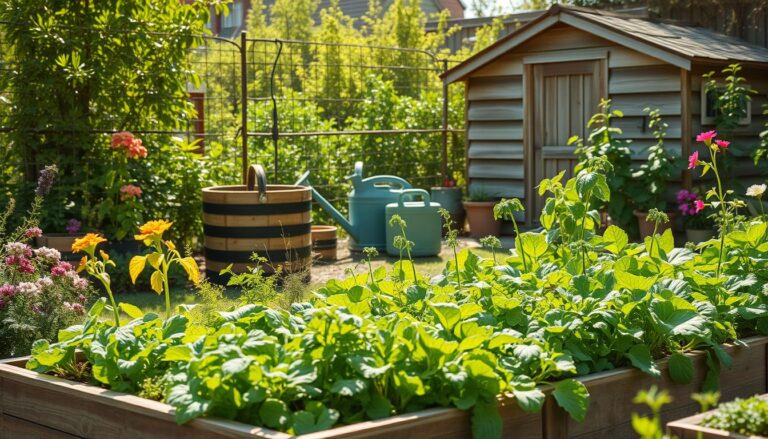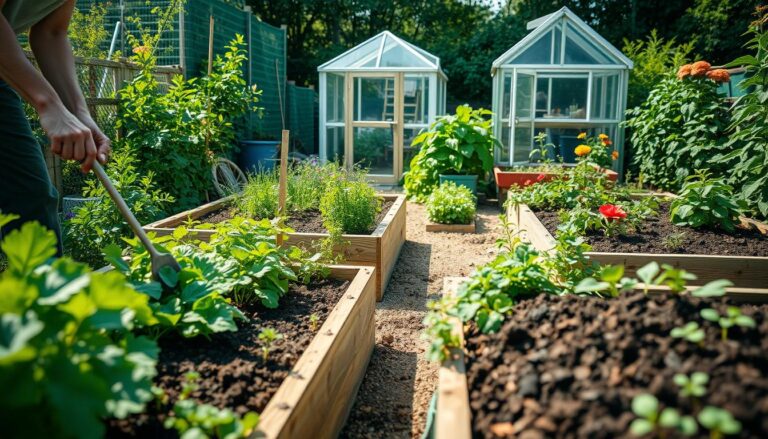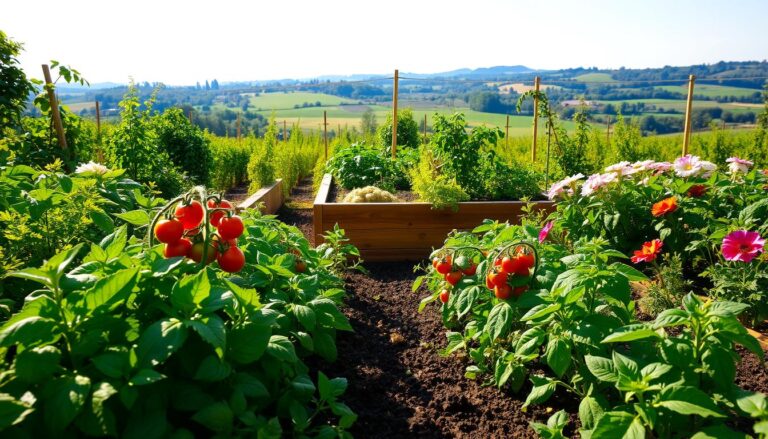Welcome to the world of sustainable gardening, where growing your own food and nurturing your green space becomes a rewarding experience. By adopting organic practices, you not only contribute to a healthier environment but also enjoy fresher produce right in your backyard.
This beginner’s guide will walk you through the basics of creating and maintaining an organic garden. You’ll learn about the benefits of sustainable gardening, from improving soil health to conserving water, and how to overcome common challenges.
By the end of this guide, you’ll be equipped with the knowledge to start your organic gardening journey, making informed decisions to create a thriving and sustainable garden.
Understanding Organic Gardening
Organic gardening stands out as a practice that harmonizes human activity with natural processes. At its core, organic gardening involves cultivating plants in a way that works with the environment, rather than against it.
What Makes Gardening “Organic”
According to the USDA, organic gardening involves using natural methods to control pests and diseases. This means avoiding synthetic fertilizers and pesticides, which can harm beneficial organisms and contaminate soil and water. Instead, organic gardeners rely on techniques like crop rotation, composting, and biological pest control to maintain a healthy and balanced ecosystem.
The Philosophy Behind Organic Methods
The philosophy behind organic gardening is rooted in a deep respect for nature and a commitment to sustainability. Organic gardeners recognize that their actions have an impact on the environment and strive to minimize their ecological footprint. By using sustainable practices, organic gardeners can create a thriving garden that is also beneficial for the planet.
Environmental and Health Benefits
The benefits of organic gardening are numerous. Not only does it promote eco-friendly gardening practices, but it also contributes to a healthier environment and provides numerous health benefits. By avoiding chemical pesticides and fertilizers, organic gardeners reduce their exposure to harmful substances. Additionally, organic gardening promotes biodiversity, improves soil health, and conserves water, making it a valuable practice for both individuals and the community.
In summary, understanding organic gardening is about grasping its core principles, appreciating its underlying philosophy, and recognizing its wide-ranging benefits. As more people adopt organic gardening methods, we move closer to a more sustainable future.
Essential Tools and Materials for Organic Gardeners
To cultivate a thriving organic garden, you’ll need some essential tools and materials. Having the right equipment not only makes gardening easier but also more efficient, allowing you to focus on nurturing your plants.
Basic Gardening Tools
Every organic gardener should have a set of basic gardening tools. These include a trowel for planting, a rake for soil preparation, and pruning shears for maintaining plant health. Gardening experts recommend investing in high-quality, durable tools that will withstand the rigors of gardening.
| Tool | Use | Benefit |
|---|---|---|
| Trowel | Planting seeds and seedlings | Precise planting |
| Rake | Soil preparation and leveling | Evens out soil surface |
| Pruning Shears | Trimming and pruning plants | Promotes healthy plant growth |
Organic Soil Amendments
Organic soil amendments are crucial for maintaining soil health. Compost is one of the most effective amendments, adding nutrients and improving soil structure. As gardening expert,
“Compost is the key to a fertile garden, teeming with life and nutrients.”
Other amendments includemanureandgreen sand, which provide essential micronutrients.
Sustainable Containers and Materials
When it comes to containers, opting for sustainable materials is key. Biodegradable pots made from materials like coconut coir or bamboo are excellent choices. They reduce waste and can be planted directly into the ground, minimizing root disturbance.
- Biodegradable pots
- Recycled plastic containers
- Wooden planters
By choosing the right tools and materials, organic gardeners can create a sustainable and thriving garden ecosystem.
Planning Your Organic Garden Space
Effective garden planning is the foundation of a thriving organic garden. It involves understanding your growing conditions, designing your garden layout, and choosing the right planting options.
Assessing Your Growing Area
The first step in planning your organic garden is to assess your growing area. This involves evaluating the size of your garden, the condition of your soil, and the existing features such as trees, slopes, or other gardens.
Understanding Sun Exposure and Microclimates
Understanding how sunlight affects your garden is crucial. Observe your garden throughout the day to identify areas that receive full sun, partial shade, or full shade. Additionally, be aware of microclimates within your garden, which are small areas with unique conditions different from the surrounding areas.
Garden Layout and Design Basics
A well-designed garden layout not only looks appealing but also improves plant health and productivity. Consider the mature size of plants when spacing them and plan for easy access to all parts of your garden.
Raised Beds vs. In-Ground Planting
Deciding between raised beds and in-ground planting depends on your soil condition, drainage needs, and personal preference. Raised beds offer better drainage and warmer soil temperatures, while in-ground planting can be more cost-effective and less labor-intensive.
Container Gardening Options
Container gardening is a versatile option for those with limited space or poor soil. It allows for better control over soil quality and drainage. Choose containers that are at least 5-7 gallons for most vegetables and ensure they have adequate drainage holes.
| Gardening Method | Drainage | Soil Control | Initial Cost |
|---|---|---|---|
| Raised Beds | Excellent | High | Moderate |
| In-Ground Planting | Variable | Low | Low |
| Container Gardening | High | High | High |
By carefully planning your organic garden space, you can create a productive and enjoyable gardening experience. Whether you choose raised beds, in-ground planting, or container gardening, understanding your garden’s unique conditions will help you make informed decisions.
Building Healthy Soil: The Foundation of Organic Gardening
Understanding and improving soil health is essential for organic gardeners. Healthy soil supports plant growth, improves crop yields, and helps in maintaining biodiversity. It’s the foundation upon which successful organic gardening is built.
Understanding Soil Types and Testing
Soil comes in various types, including clay, silt, sand, and loam, each with its unique characteristics. Soil testing is a critical step in understanding your soil’s pH level and nutrient content. Soil testing kits are readily available at most gardening stores, making it easier for gardeners to assess their soil condition.
By understanding your soil type, you can make informed decisions about amendments and fertilizers. For instance, clay soils may require more organic matter to improve drainage, while sandy soils might need more frequent additions to retain nutrients.
Composting Fundamentals
Composting is a natural process that turns organic materials into a rich soil amendment. It involves breaking down kitchen scraps, leaves, and other organic materials into a form that plants can easily absorb. Composting not only reduces waste but also enriches the soil, improving its structure and fertility.
To start composting, gardeners can include a variety of organic matter sources such as kitchen waste, grass clippings, and fallen leaves. It’s essential to balance “green” materials (like kitchen scraps) with “brown” materials (like dried leaves) to create a healthy compost pile.
Natural Soil Amendments and Fertilizers
In addition to composting, gardeners can use various natural soil amendments and fertilizers to enhance soil health. These include organic matter sources like manure, peat moss, and compost tea.
Organic Matter Sources
Organic matter sources are vital for improving soil structure and fertility. Examples include well-rotted manure, which adds nutrients, and peat moss, which helps retain moisture.
Mineral Supplements
Mineral supplements like lime and gypsum can also be used to adjust soil pH and improve its structure. Lime, for instance, can help raise the pH of acidic soils, while gypsum can improve drainage in clay soils.
By combining these practices—understanding soil types, composting, and using natural amendments—organic gardeners can build healthy, productive soil that supports a thriving garden ecosystem.
Beginner Guide to Organic Gardening: Selecting and Starting Plants
As you start your organic gardening journey, understanding how to select and start plants is essential. The right choices will not only make your gardening experience more enjoyable but also more productive.
Choosing Beginner-Friendly Plants
For beginners, it’s crucial to start with plants that are easy to grow and require minimal maintenance. Tomatoes and zucchini are often recommended because they are hardy and produce a high yield. Other beginner-friendly plants include leafy greens like spinach and lettuce, which grow quickly and can be harvested in as little as three weeks.
Understanding Plant Families and Companions
Understanding the different plant families and their companions can significantly enhance your gardening success. Some plants, when grown together, can improve growth, flavor, and pest resistance. For example, marigolds are known to deter nematodes, making them excellent companions for tomatoes. Researching which plants complement each other can help you create a harmonious and thriving garden ecosystem.
Starting Seeds vs. Buying Seedlings
One of the decisions you’ll need to make is whether to start your plants from seeds or buy seedlings. Starting seeds can be cost-effective and gives you a wider variety of plants to choose from. However, it requires more time and care. Buying seedlings can give you a head start, especially in cooler climates where the growing season is shorter.
“Starting seeds is an exciting process that allows gardeners to connect with the natural cycle of growth from the very beginning,”
says gardening expert, Jane Smith.
Heirloom and Organic Seed Sources
When selecting seeds, consider choosing heirloom and organic varieties. Heirloom seeds offer unique flavors and characteristics that have been preserved over generations. Organic seeds ensure that your garden remains free from genetically modified organisms (GMOs) and chemicals. Reputable sources for these seeds include Baker Creek Heirloom Seeds and Seed Savers Exchange, both known for their vast collections and commitment to preserving heirloom varieties.
By carefully selecting and starting your plants, you set the stage for a successful and fulfilling organic gardening experience. Whether you’re growing a few herbs on your windowsill or managing a large vegetable garden, the principles of choosing the right plants and understanding their needs remain crucial.
Natural Pest and Disease Management
Effective natural pest and disease management is key to a thriving organic garden. By understanding the balance between pests and beneficial organisms, gardeners can create a healthy ecosystem that minimizes the need for external interventions.
Identifying Common Garden Pests
The first step in managing pests is to identify them. Common garden pests include aphids, slugs, and caterpillars. Regular monitoring is crucial to catch infestations early.
Beneficial Insects and Biodiversity
Encouraging beneficial insects is a cornerstone of natural pest control. Ladybugs and lacewings are natural predators of many common pests. Creating a diverse garden ecosystem by planting a variety of flowers and herbs can attract these beneficial insects.
“A diverse garden is not just more beautiful, it’s also more resilient and healthier.”
Organic Pest Control Methods
When pests become a problem, organic gardeners have several control methods at their disposal.
Preventive Strategies
- Using physical barriers to prevent pests from reaching plants
- Practicing good garden hygiene to reduce disease spread
- Crop rotation to break pest and disease cycles
Natural Remedies and Solutions
For more severe infestations, natural remedies can be effective. Neem oil and insecticidal soap are popular choices for controlling a wide range of pests.
| Pest | Natural Control Method |
|---|---|
| Aphids | Ladybugs, neem oil |
| Slugs | Copper tape, beer traps |
| Caterpillars | Hand-picking, Bt (Bacillus thuringiensis) |
By combining these strategies, organic gardeners can effectively manage pests and diseases, ensuring a healthy and productive garden.
Water Conservation and Irrigation Techniques
Conserving water in your organic garden not only benefits the environment but also enhances your garden’s productivity. As we delve into the world of organic gardening, it’s essential to understand the importance of efficient water use.
Efficient Watering Practices
Efficient watering practices are crucial for minimizing water waste and ensuring that your plants receive the right amount of moisture. Drip irrigation and soaker hoses are effective methods that deliver water directly to the roots, reducing evaporation and runoff.
Mulching for Moisture Retention
Mulching is a simple yet effective technique for retaining soil moisture. By applying a layer of organic mulch around your plants, you can significantly reduce water loss due to evaporation and soil erosion. Organic mulches like wood chips, straw, and leaves not only conserve water but also add nutrients to the soil as they decompose.
Rainwater Harvesting Basics
Rainwater harvesting is another excellent strategy for conserving water. By collecting and storing rainwater, you can reduce your reliance on municipal water supplies and create a sustainable source of irrigation water. Installing a rainwater harvesting system can be as simple as placing a barrel under your downspout.
Drought-Tolerant Gardening Strategies
For areas prone to drought, selecting drought-tolerant plants is a wise strategy. These plants are adapted to survive with minimal watering, reducing the need for frequent irrigation. Additionally, improving soil structure through composting and mulching can enhance the soil’s water-holding capacity, making it more resilient during dry periods.
By implementing these water conservation and irrigation techniques, you can create a more sustainable and resilient organic garden that thrives with minimal environmental impact.
Seasonal Organic Gardening Tasks
Organic gardening is a year-round endeavor, with each season bringing its own set of tasks and opportunities. Understanding and adapting to these seasonal changes is key to maintaining a healthy and productive garden.
Spring Preparation and Planting
Spring is a time of renewal in the garden. As the soil becomes workable, it’s time to start preparing for the growing season. This includes cleaning up debris, testing soil pH, and adding organic amendments as needed.
- Begin by removing any winter debris and weeds.
- Test your soil to determine its nutrient content and pH level.
- Add compost or well-rotted manure to improve soil fertility.
Summer Maintenance and Care
Summer is the peak growing season, and your garden will require regular maintenance. Watering efficiently and controlling pests are crucial during this time.
- Water plants deeply but infrequently to encourage deep root growth.
- Keep an eye out for common pests and diseases, using organic control methods whenever possible.
Fall Harvesting and Garden Cleanup
Fall is a time of harvest, but it’s also essential to start preparing the garden for the coming winter. Cleaning up the garden and adding organic matter to the soil are key tasks.
- Harvest crops before the first frost.
- Clean up garden beds, removing spent plants and weeds.
- Add compost or leaf mold to the soil to improve its structure.
Winter Planning and Soil Preparation
Winter is a time for planning and preparation. Reviewing your garden’s performance and planning for the next growing season can help ensure continued success.
“The garden is a love song, a duet between a human being and Mother Nature.” – Jeff Cox
Use this time to:
- Review your garden’s performance over the past year.
- Plan crop rotations and new garden layouts.
- Order seeds and supplies for the upcoming season.
Conclusion
As we conclude this beginner’s guide to organic gardening, it’s clear that starting your organic gardening journey is simpler than you think. By understanding the principles of organic gardening, preparing your garden space, and adopting natural methods for pest control and soil health, you can create a thriving and sustainable garden.
This organic gardening summary highlights the key steps to get you started: assessing your growing area, building healthy soil, selecting the right plants, and conserving water. By following these steps, you’ll not only grow your own food but also contribute to a healthier environment.
As you begin your organic gardening journey, remember that every small step counts. Start with a few plants, learn from your experiences, and gradually expand your garden. The beginner’s guide conclusion is just the start of your exciting journey into the world of organic gardening.
FAQ
What is organic gardening?
Why is soil testing important in organic gardening?
What are some beginner-friendly plants for organic gardening?
How can I manage pests naturally in my organic garden?
What are some efficient watering practices for organic gardening?
How do I choose the right organic soil amendments?
What are the benefits of using raised beds in organic gardening?
How can I start seeds for my organic garden?
What are some seasonal tasks I should perform in my organic garden?

Sortemdia nasceu com o propósito de trazer alegria e oportunidades para todos por meio de sorteios gratuitos de prêmios incríveis. O site tem como missão oferecer experiências acessíveis, divertidas e justas para quem deseja concorrer a produtos, serviços e brindes sem pagar nada por isso. Acreditamos que a sorte pode bater à porta de qualquer pessoa — e no Sortemdia, ela pode chegar com apenas um clique.



